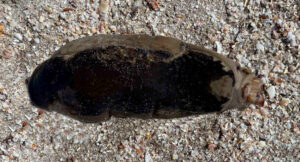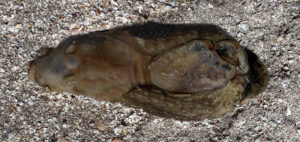California Sea Hare, Aplysia californica

 California Sea Hare, Aplysia californica. Mollusk collected off the beach of Punta Chivato, Baja California Sur, May 2023. Size: 15.2 cm (6.0). Collection, photographs and identification courtesy of Colin Campbell, DVM, Punta Chivato.
California Sea Hare, Aplysia californica. Mollusk collected off the beach of Punta Chivato, Baja California Sur, May 2023. Size: 15.2 cm (6.0). Collection, photographs and identification courtesy of Colin Campbell, DVM, Punta Chivato.
Phylogeny: The California Sea Hare, Aplysia californica, is a member of the Aplysiidae Family of Sea Hares. They are also known as as the California Brown Sea Hare and in Mexico as Liebre de Mar de California.
Morphology: The California Sea Hare has a large humped body has flaps that project dorsally on each side. The shell is partially calcified This species is typically reddish-brown to greenish-brown, but their color shifts to resemble the color of the algae they consume. The head exhibits two sets of tentacles. One set is found on top of the head behind the eyes and the other set is on the front of their face above the mouth. This often makes them blend into their habitat when surrounded by seaweed, an adaption that allows them to stay conspicuous from predators. They have a toothed radula that allows them to graze on algae attached to surfaces. They vary in length from 15 cm (5.9 inches) to up to 76 cm (30 inches).
Habitat & Distribution: The California Sea Hare resides in the photic zone, typically in intertidal zones. It is found throughout the Gulf of California, along the Pacific Coast of Baja California north to California.
Diet: The California Sea Hare and all members of the Aplysiidae Family are herbivorous, feeding on various species of algae including Laurencia pacifica, Plocamium pacificum, and Ceramium eatonianum.
Predators: The California Sea Hare is toxic as it consumes strictly toxic algae and is avoided by most predators. However, the Green Sea Anemone, Anthropleura xanthogrammica, and the ophistobranch, Navaranax, Navanax inermis, are common predators of this sea hare. They also have the ability to release a dark purple ink to confuse their predators.
Reproduction: The California Sea Hare is hermaphroditic. Their eggs are deposited as long, tangled skeins with yellow, yellow-green, or pink eggs. One individual can deposit up to 750,000 eggs per season. This is an example of an r-selected species which has high fecundity, small offspring, and short lifespans.
Life Cycle: The California Sea Hare has a life span of approximately one year. After emerging from the egg masses, the trochophore larvae remain free-swimming organisms for one to two months before settling on red algae to begin metamorphosis into their adult form. After that, they reach their reproductive peak at about seven months.
Economic Importance: Sea hare eggs are often consumed as a delicacy in the Philippines. In addition, the California Sea Hare is used to study neurobiology due to its large neurons. In fact, it has the largest neurons in the animal kingdom.
Synonyms: Aplysia (Neaplysia) nettiae, Aplysia ritteri, Tethys (Neaplysia) californica, Tethys (Neaplysia) ritteri, Tethys californicus